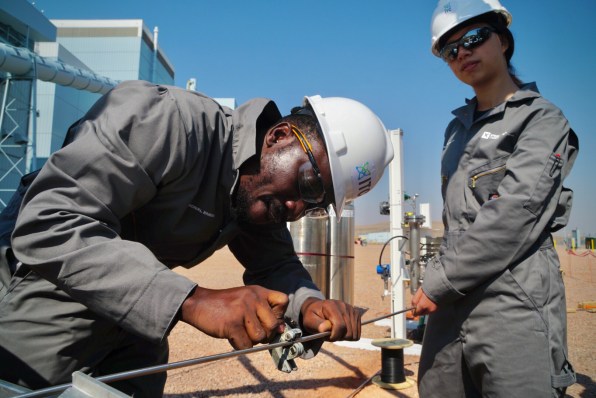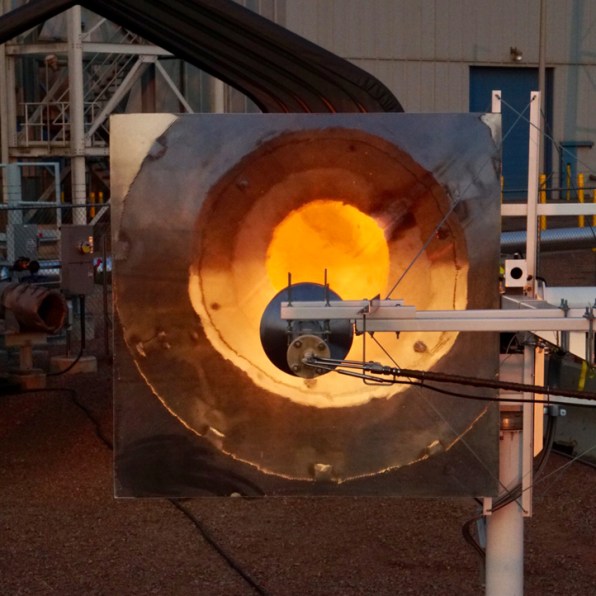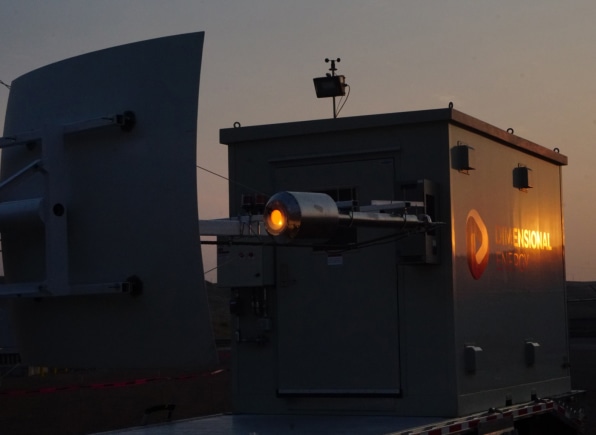This startup is using sunlight and captured CO2 to make jet fuel
In the future, your flights could be powered by recycled carbon emissions.
![]()
In a field in the desert next to a freeway in Tucson, Arizona, the sun beams down on a large mirror in a research park, powering a small reactor nearby. Inside that reactor, captured carbon dioxide is being transformed into synthetic jet fuel.
“We remove the need for any sort of fossil fuel inputs,” says Jason Salfi, cofounder and CEO of Dimensional Energy, the startup running the small pilot installation. By early next year, the tiny facility will be producing only around half a barrel of fuel a day. But the company plans to use the same process—with a large field of heliostats, which are mirrors that concentrate solar power—at a sizable scale. In 2022, it hopes to get its sustainable aviation fuel certified for use and begin flight tests with a partner airline. The company is one of a handful of startups developing alternative jet fuels (LanzaTech, which turns steel-factory emissions into ethanol, is another).

In the future, your flights could be powered by recycled carbon emissions.
In a field in the desert next to a freeway in Tucson, Arizona, the sun beams down on a large mirror in a research park, powering a small reactor nearby. Inside that reactor, captured carbon dioxide is being transformed into synthetic jet fuel.
“We remove the need for any sort of fossil fuel inputs,” says Jason Salfi, cofounder and CEO of Dimensional Energy, the startup running the small pilot installation. By early next year, the tiny facility will be producing only around half a barrel of fuel a day. But the company plans to use the same process—with a large field of heliostats, which are mirrors that concentrate solar power—at a sizable scale. In 2022, it hopes to get its sustainable aviation fuel certified for use and begin flight tests with a partner airline. The company is one of a handful of startups developing alternative jet fuels (LanzaTech, which turns steel-factory emissions into ethanol, is another).

[Photo: courtesy Dimensional Energy]For the airline industry, which emitted 918 million tons of CO2 in 2019 before the pandemic temporarily slowed travel, the technology could be part of a larger transformation. Electric planes are in development, but are only likely to be feasible for short flights and small aircraft in the near future. “Right now, the energy density of the batteries are several times less than the energy density of the hydrocarbon fuels,” says Salfi, “so you just simply can’t store enough energy to fly long distances and to fly large amounts of passengers.” The company’s process could also be used to make fuel for long-distance trucking or shipping.


[Photo: courtesy Dimensional Energy]The technology, which grew out of research at Cornell University, uses electrolysis to split water and produce hydrogen, and then mixes the hydrogen and CO2 in its reactor to make syngas, or synthetic gas—which can be converted into liquid fuel and then refined into jet fuel. “The magic of our technology is where we integrate everything into one single stream,” he says. The tech makes it possible to make carbon monoxide, one component of the process, at a low cost, and makes the resulting fuel cost competitive. At scale, the company projects that the fuel could eventually cost less than $1 per gallon.
 [Photo: courtesy Dimensional Energy]“Our financial models show being able to have cost parity with fossil fuel-based jet fuel in the next decade,” says Salfi. It’s critical to get there if airlines are going to buy it. “It’s going to be a struggle to get them to pay a premium for any meaningful amount of sustainable aviation fuel,” he says. “Even if they are paying a premium today, sustainable aviation fuel only makes up something like less than a tenth of a percent of the overall market. . . . [T]hey just won’t respond unless it’s in their pricing model. Companies like ours just have to get the prices down.”
[Photo: courtesy Dimensional Energy]“Our financial models show being able to have cost parity with fossil fuel-based jet fuel in the next decade,” says Salfi. It’s critical to get there if airlines are going to buy it. “It’s going to be a struggle to get them to pay a premium for any meaningful amount of sustainable aviation fuel,” he says. “Even if they are paying a premium today, sustainable aviation fuel only makes up something like less than a tenth of a percent of the overall market. . . . [T]hey just won’t respond unless it’s in their pricing model. Companies like ours just have to get the prices down.”

 [Photo: courtesy Dimensional Energy]“Our financial models show being able to have cost parity with fossil fuel-based jet fuel in the next decade,” says Salfi. It’s critical to get there if airlines are going to buy it. “It’s going to be a struggle to get them to pay a premium for any meaningful amount of sustainable aviation fuel,” he says. “Even if they are paying a premium today, sustainable aviation fuel only makes up something like less than a tenth of a percent of the overall market. . . . [T]hey just won’t respond unless it’s in their pricing model. Companies like ours just have to get the prices down.”
[Photo: courtesy Dimensional Energy]“Our financial models show being able to have cost parity with fossil fuel-based jet fuel in the next decade,” says Salfi. It’s critical to get there if airlines are going to buy it. “It’s going to be a struggle to get them to pay a premium for any meaningful amount of sustainable aviation fuel,” he says. “Even if they are paying a premium today, sustainable aviation fuel only makes up something like less than a tenth of a percent of the overall market. . . . [T]hey just won’t respond unless it’s in their pricing model. Companies like ours just have to get the prices down.”
[Photo: courtesy Dimensional Energy]Dimensional Energy plans to begin its process with CO2 captured from industry—for example, cement plants, which produce carbon dioxide as part of the chemical process even if they’re able to run on renewable energy. Eventually, as direct air capture technology scales up to pull CO2 from the atmosphere, it could also be a source for the fuel, making it essentially carbon neutral. (Direct air capture also produces water, which could be used to make hydrogen in the process.) Other sources are also possible. New technology that captures CO2 from trucks as they drive, for example, could theoretically be the source for new fuel for those trucks.
At the moment, regulations limit the amount of synthetic fuel that planes can use, allowing a mix of up to 50%. That would still dramatically lower the carbon footprint of flights, but it’s possible that 100% sustainable aviation fuel may soon be allowed. The fuel could also eventually be used on hybrid aircraft that use fuel for energy-intensive takeoff, but then run on electric power in the sky.
At the moment, regulations limit the amount of synthetic fuel that planes can use, allowing a mix of up to 50%. That would still dramatically lower the carbon footprint of flights, but it’s possible that 100% sustainable aviation fuel may soon be allowed. The fuel could also eventually be used on hybrid aircraft that use fuel for energy-intensive takeoff, but then run on electric power in the sky.
No comments:
Post a Comment